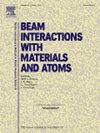Fast measurement of the quasi-monochromatic MeV γ-beam flux using the 63Cu( γ, n)62Cu reaction at the Shanghai Laser Electron Gamma Source
IF 1.4
3区 物理与天体物理
Q3 INSTRUMENTS & INSTRUMENTATION
Nuclear Instruments & Methods in Physics Research Section B-beam Interactions With Materials and Atoms
Pub Date : 2025-02-01
DOI:10.1016/j.nimb.2024.165595
引用次数: 0
Abstract
Shanghai Laser Electron Gamma Source (SLEGS) is a powerful laser-Compton scattering (LCS) -ray facility that provides a quasi-monochromatic MeV -ray beam with a moderate flux of 10-10 photons/s. Accurate and fast measurement of the SLEGS -beam flux is critical for the upcoming photonuclear experiments. In this study, an activation method based on 63Cu(, n)62Cu reaction is proposed for fast measurement of the SLEGS -beam flux. By operating at a low beam flux of 10-10 photons/s, the SLEGS -beam flux is measured within the energy range of 11.66-19.08 MeV. The -beam flux as a function of laser power is also investigated. It was found that the flux data obtained by the proposed method is in reasonable agreement with the online monitoring of the LaBr detector and the GEANT4 simulations. The dependence of the total time (the sum of the irradiation time, the cooling time, and the detection time for identifying characteristic -ray emission) on the -beam flux is further studied. The total time could be controlled within 100 s when the beam flux exceeds 10 photons/s, suggesting the great potential of the 63Cu activation method to quasi-real-time measure the LCS -ray beam at high flux conditions.
上海激光电子伽玛源63Cu(γ, n)62Cu反应准单色MeV γ束流通量的快速测量
上海激光电子伽马源(SLEGS)是一种强大的激光康普顿散射(LCS) γ射线设备,可提供准单色MeV γ射线束,中等通量为105-107光子/秒。准确、快速地测量SLEGS γ束流通量对即将到来的光核实验至关重要。本研究提出了一种基于63Cu(γ, n)62Cu反应的激活方法,用于快速测量SLEGS γ束流通量。在104 ~ 105光子/s的低束流下,SLEGS的γ束流在11.66 ~ 19.08 MeV的能量范围内测量。研究了γ束流通量随激光功率的变化规律。结果表明,该方法得到的通量数据与LaBr3探测器在线监测和GEANT4模拟结果吻合较好。进一步研究了总时间(辐照时间、冷却时间和识别特征γ射线发射的检测时间)与γ束流通量的关系。当束流通量超过108光子/s时,总时间可控制在100 s以内,表明63Cu激活法在高通量条件下准实时测量LCS γ射线束具有很大的潜力。
本文章由计算机程序翻译,如有差异,请以英文原文为准。
求助全文
约1分钟内获得全文
求助全文
来源期刊
CiteScore
2.80
自引率
7.70%
发文量
231
审稿时长
1.9 months
期刊介绍:
Section B of Nuclear Instruments and Methods in Physics Research covers all aspects of the interaction of energetic beams with atoms, molecules and aggregate forms of matter. This includes ion beam analysis and ion beam modification of materials as well as basic data of importance for these studies. Topics of general interest include: atomic collisions in solids, particle channelling, all aspects of collision cascades, the modification of materials by energetic beams, ion implantation, irradiation - induced changes in materials, the physics and chemistry of beam interactions and the analysis of materials by all forms of energetic radiation. Modification by ion, laser and electron beams for the study of electronic materials, metals, ceramics, insulators, polymers and other important and new materials systems are included. Related studies, such as the application of ion beam analysis to biological, archaeological and geological samples as well as applications to solve problems in planetary science are also welcome. Energetic beams of interest include atomic and molecular ions, neutrons, positrons and muons, plasmas directed at surfaces, electron and photon beams, including laser treated surfaces and studies of solids by photon radiation from rotating anodes, synchrotrons, etc. In addition, the interaction between various forms of radiation and radiation-induced deposition processes are relevant.

 求助内容:
求助内容: 应助结果提醒方式:
应助结果提醒方式:


